Impact of Sea Ice on the Hydrodynamics and Suspended Sediment Concentration in the Coastal Waters of Qinhuangdao, China
Abstract
1. Introduction
2. Data Collection and Analysis
2.1. Mooring Data
2.2. Harmonic Analysis
2.3. Suspended Sediment Concentration (SSC) Represented by Backscatter Intensity
2.4. Turbulent Kinetic Energy (TKE) Calculation Method
3. Results Analysis
3.1. Wind, Temperature, and Salinity
3.2. Impact of Sea Ice on Hydrodynamics
3.2.1. Water Depth Changes
3.2.2. Original Velocity Profile at Full Water Depth
3.2.3. Tides
3.2.4. Residual Current and Wind Speed
3.3. Impact of Sea Ice on Suspended Sediment Concentration
3.3.1. Vertical Profile of Backscatter Intensity at Full Water Depth
3.3.2. Volume Concentration, Particle Size Distribution, and Turbidity of Suspended Sediment at the Bottom Layer
4. Discussion
4.1. Causes of Low SSC under the Impact of Sea Ice
4.2. Vertical Distribution of Velocity and SSC with or without Sea Ice
5. Conclusions
Author Contributions
Funding
Acknowledgments
Conflicts of Interest
References
- McGraw, M.C.; Barnes, E.A. New Insights on Subseasonal Arctic-Midlatitude Causal Connections from a Regularized Regression Model. J. Clim. 2020, 33, 213–228. [Google Scholar] [CrossRef]
- Ayarzagüena, B.; Screen, J.A. Future Arctic sea ice loss reduces severity of cold air outbreaks in midlatitudes. Geophys. Res. Lett. 2016, 43, 2801–2809. [Google Scholar] [CrossRef]
- Francis, J.A. The Arctic matters: Extreme weather responds to diminished Arctic Sea ice. Environ. Res. Lett. 2015, 10, 091002. [Google Scholar] [CrossRef]
- Petoukhov, V.; Semenov, V.A. A link between reduced Barents-Kara sea ice and cold winter extremes over northern continents. J. Geophys. Res. 2010, 115, D21111. [Google Scholar] [CrossRef]
- Parkinson, C.L.; Cavalieri, D.J.; Gloersen, P.; Zwally, H.J.; Comiso, J.C. Arctic sea ice extents, areas, and trends, 1978–1996. J. Geophys. Res. Oceans 1999, 104, 20837–20856. [Google Scholar] [CrossRef]
- Overpeck, J. Arctic Environmental Change of the Last Four Centuries. Science 1997, 278, 1251–1256. [Google Scholar] [CrossRef]
- Liu, W.; Fedorov, A.; Sévellec, F. The mechanisms of the Atlantic Meridional Overturning Circulation slowdown induced by Arctic sea ice decline. J. Clim. 2019, 32, 977–996. [Google Scholar] [CrossRef]
- Liu, W.; Fedorov, A.V. Timescales and mechanisms of global climate impacts of Arctic sea ice loss mediated by the Atlantic meridional overturning circulation. Geophys. Res. Lett. 2019, 46, 944–952. [Google Scholar] [CrossRef]
- Stein, R. The late Mesozoic—Cenozoic Arctic Ocean climate and sea ice history: A challenge for past and future scientific ocean drilling. Paleoceanogr. Paleoclimatol. 2019, 34, 1851–1894. [Google Scholar] [CrossRef]
- Kern, S.; Lavergne, T.; Notz, D.; Pedersen, L.T.; Tonboe, R.T.; Saldo, R.; Sørensen, A.M. Satellite passive microwave sea ice concentration data set intercomparison: Closed ice and ship-based observations. Cryosphere Copernic. Publ. 2019, 13, 3261–3307. [Google Scholar] [CrossRef]
- Screen, J.A.; Simmonds, I. The central role of diminishing sea ice in recent Arctic temperature amplification. Nature 2010, 464, 1334–1337. [Google Scholar] [CrossRef] [PubMed]
- Comiso, J.C.; Parkinson, C.L.; Gersten, R.; Stock, L. Accelerated decline in the Arctic sea ice cover. Geophys. Res. Lett. 2008, 35, L01703. [Google Scholar] [CrossRef]
- Jiao, C.; Zhang, W.; Dong, S. Statistical Prediction for Annual Start Date and Duration of Sea ice Coverage at Qinhuangdao Observation Station. J. Ocean Univ. Chin. 2019, 18, 1265–1272. [Google Scholar] [CrossRef]
- Manson, G.K.; Davidson-Arnott, R.G.D.; Ollerhead, J. Attenuation of Wave Energy by Nearshore Sea Ice: Prince Edward Island, Canada. J. Coastal Res. 2016, 318, 253–263. [Google Scholar]
- Kug, J.-S.; Jeong, J.-H.; Jang, Y.-S.; Kim, B.-M.; Folland, C.K.; Min, S.-K.; Son, S.-W. Two distinct influences of Arctic warming on cold winters over North America and East Asia. Nat. Geosci. 2015, 8, 759–762. [Google Scholar] [CrossRef]
- Grebmeier, J.; Frey, K.; Cooper, L.; Kędra, M. Trends in Benthic Macrofaunal Populations, Seasonal Sea Ice Persistence, and Bottom Water Temperatures in the Bering Strait Region. Oceanography 2018, 31, 136–151. [Google Scholar] [CrossRef]
- Wegner, C.; Wittbrodt, K.; Hölemann, J.A.; Janout, M.A.; Krumpen, T.; Selyuzhenok, V.; Timokhov, L. Sediment entrainment into sea ice and transport in the Transpolar Drift: A case study from the Laptev Sea in winter 2011/2012. Cont. Shelf Res. 2017, 141, 1–10. [Google Scholar] [CrossRef]
- Forest, A.; Osborne, P.D.; Curtiss, G.; Lowings, M.G. Current surges and seabed erosion near the shelf break in the Canadian Beaufort Sea: A response to wind and ice motion stress. J. Mar. Syst. 2016, 160, 1–16. [Google Scholar] [CrossRef]
- Sanchez-Vidal, A.; Veres, O.; Langone, L.; Ferré, B.; Calafat, A.; Canals, M.; Danovaro, R. Particle sources and downward fluxes in the eastern Fram strait under the influence of the west Spitsbergen current. Deep Sea Res. Part I 2015, 103, 49–63. [Google Scholar] [CrossRef]
- Eicken, H.; Gradinger, R.; Gaylord, A.; Mahoney, A.; Rigor, I.; Melling, H. Sediment transport by sea ice in the Chukchi and Beaufort Seas: Increasing importance due to changing ice conditions? Deep Sea Res. Part II 2005, 52, 3281–3302. [Google Scholar] [CrossRef]
- Boone, W.; Rysgaard, S.; Kirillov, S.; Dmitrenko, I.; Bendtsen, J.; Mortensen, J.; Barber, D.G. Circulation and fjord-shelf exchange during the ice-covered period in Young Sound-Tyrolerfjord, Northeast Greenland (74° N). Estuar. Coast. Shelf Sci. 2017, 194, 205–216. [Google Scholar] [CrossRef]
- Miller, M.F.; Fan, Z.; Bowser, S.S. Sediments Beneath Multi-Year Sea Ice: Delivery By Deltaic and Eolian Processes. J. Sediment. Res. 2015, 85, 301–314. [Google Scholar] [CrossRef]
- Murray, K.T.; Miller, M.F.; Bowser, S.S. Depositional processes beneath coastal multi-year sea ice. Sedimentology 2012, 60, 391–410. [Google Scholar] [CrossRef]
- Walker, T.R.; Grant, J.; Cranford, P.; Lintern, D.G.; Hill, P.; Jarvis, P.; Nozais, C. Suspended sediment and erosion dynamics in Kugmallit Bay and Beaufort Sea during ice-free conditions. J. Mar. Syst. 2008, 74, 794–809. [Google Scholar] [CrossRef]
- Drews, C. Using Wind Setdown and Storm Surge on Lake Erie to Calibrate the Air-Sea Drag Coefficient. PLoS ONE 2013, 8, e72510. [Google Scholar] [CrossRef]
- Peck, L.S.; Barnes, D.K.A.; Willmott, J. Responses to extreme seasonality in food supply: Diet plasticity in Antarctic brachiopods. Mar. Biol. 2005, 147, 453–463. [Google Scholar] [CrossRef]
- Giesbrecht, T.; Sim, N.; Orians, K.J.; Cullen, J.T. The distribution of dissolved and total dissolvable aluminum in the Beaufort Sea and Canada Basin region of the Arctic Ocean. J. Geophys. Res. Oceans. 2013, 118, 6824–6837. [Google Scholar] [CrossRef]
- Bonsell, C.; Dunton, K.H. Long-term patterns of benthic irradiance and kelp production in the central Beaufort sea reveal implications of warming for Arctic inner shelves. Prog. Oceanogr. 2018, 162, 160–170. [Google Scholar] [CrossRef]
- Lannuzel, D.; Schoemann, V.; de Jong, J.; Pasquer, B.; van der Merwe, P.; Masson, F.; Bowie, A. Distribution of dissolved iron in Antarctic sea ice: Spatial, seasonal, and inter-annual variability. J. Geophys. Res. 2010, 115, G03022. [Google Scholar] [CrossRef]
- Forest, A.; Sampei, M.; Makabe, R.; Sasaki, H.; Barber, D.G.; Gratton, Y.; Fortier, L. The annual cycle of particulate organic carbon export in Franklin Bay (Canadian Arctic): Environmental control and food web implications. J. Geophys. Res. 2008, 113, C03S05. [Google Scholar]
- Pang, C.G.; Yu, W. Spatial modes of suspended sediment concentration in surface water in Bohai Sea and their temporal variations. Adv. Water Sci. 2013, 24, 722–727, (in Chinese with English abstract). [Google Scholar]
- Yuan, D.L.; Zhu, J.R.; Li, C.Y.; Hu, D.X. Cross-shelf circulation in the Yellow and East China Seas indicated by MODIS satellite observations. J. Mar. Syst. 2008, 70, 134–149. [Google Scholar] [CrossRef]
- National Marine Environmental Forecasting Center. Available online: http://www.nmefc.cn/haibing/jingbaodetail.aspx (accessed on 16 February 2020).
- RD Instruments. Principles of Operation A Practical Primer; RD Instruments: San Diego, CA, USA, 1996; pp. 38–39. [Google Scholar]
- Lan, Z.G.; Gong, D.J.; Yu, X.S.; Li, S.R.; Xu, Y.P. Particle size correction of suspended sediment concentration measured by ADCP with in-situ particle size analyzer. Oceanol. Limnol. Sin. 2004, 35, 385–392, (in Chinese with English abstract). [Google Scholar]
- Deines, K.L. Backscatter estimation using broadband acoustic Doppler Current Profilers. In Proceedings of the IEEE Sixth Working Conference on Current Measurement, San Diego, CA, USA, 13 March 1999; pp. 249–253. [Google Scholar]
- Soulsby, R.L.; Dyer, K.R. The form of the near-bed velocity profile in a tidally accelerating flow. J. Geophys. Res. 1981, 86, 8067. [Google Scholar] [CrossRef]
- Stapleton, K.R.; Huntley, D.A. Seabed stress determinations using the inertial dissipation method and the turbulent kinetic energy method. Earth Surf. Process. Landforms. 1995, 20, 807–815. [Google Scholar] [CrossRef]
- Kim, S.-C.; Friedrichs, C.T.; Maa, J.P.-Y.; Wright, L.D. Estimating Bottom Stress in Tidal Boundary Layer from Acoustic Doppler Velocimeter Data. J. Hydraul. Eng. 2000, 126, 399–406. [Google Scholar] [CrossRef]
- Zhu, Q.; van Prooijen, B.C.; Wang, Z.B.; Ma, Y.X.; Yang, S.L. Bed shear stress estimation on an open intertidal flat using in situ measurements. Estuar. Coast. Shelf Sci. 2016, 182, 190–201. [Google Scholar] [CrossRef]
- Yuan, Y. Observations of Suspended Sediment Dynamics in Chinese Coastal Seas by Acoustic Instruments. PhD Thesis, Ocean University of China, Qingdao, China, 5 June 2009. [Google Scholar]
- Stacey, M.T.; Monismith, S.G.; Burau, J.R. Measurements of Reynolds stress profiles in unstratified tidal flow. J. Geophys. Res. Oceans 1999, 104, 10933–10949. [Google Scholar] [CrossRef]
- Bian, C.; Liu, Z.; Huang, Y.; Zhao, L.; Jiang, W. On estimating turbulent Reynolds stress in wavy aquatic environment. J. Geophys. Res. Oceans 2018, 123, 3060–3071. [Google Scholar] [CrossRef]
- MacVean, L.J.; Lacy, J.R. Interactions between waves, sediment, and turbulence on a shallow estuarine mudflat. J. Geophys. Res. Oceans 2014, 119, 1534–1553. [Google Scholar] [CrossRef]
- Kularatne, S.; Pattiaratchi, C. Turbulent kinetic energy and sediment resuspension due to wave groups. Cont. Shelf Res. 2008, 28, 726–736. [Google Scholar] [CrossRef]
- Wright, L.; Xu, J.; Madsen, O. Across-shelf benthic transports on the inner shelf of the Middle Atlantic Bight during the “Halloween storm” of 1991. Mar. Geol. 1994, 118, 61–77. [Google Scholar] [CrossRef]
- Soulsby, R. Dynamics of Marine Sands: A Manual for Practical Applications; Tomas Telford Limited: London, UK, 1997; pp. 72–76. [Google Scholar]
- Hou, Q.Z.; Lu, Y.J.; Wang, Z.L. Cumulative impacts of high intensity reclamation in Bohai Bay on tidal wave system and its mechanism. Chin. Sci. Bull. 2017, 62, 3479–3489. [Google Scholar] [CrossRef]
- Huang, J.; Xu, J.; Gao, S.; Lian, X.; Li, J. Analysis of Influence on the Bohai Sea Tidal System Induced by Coastline Modification. J. Coastal Res. 2015, 73, 359–363. [Google Scholar] [CrossRef]
- Chang, G.C.; Dickey, T.D.; Williams, A.J. Sediment resuspension over a continental shelf during Hurricanes Edouard and Hortense. J. Geophys. Res. Oceans. 2001, 106, 9517–9531. [Google Scholar] [CrossRef]
- Glenn, S.M.; Grant, W.D. A suspended sediment stratification correction for combined wave and current flows. J. Geophys. Res. 1987, 92, 8244–8264. [Google Scholar] [CrossRef]
- Dufois, F.; Garreau, P.; Le Hir, P.; Forget, P. Wave- and current-induced bottom shear stress distribution in the Gulf of Lions. Cont. Shelf Res. 2008, 28, 1920–1934. [Google Scholar] [CrossRef][Green Version]
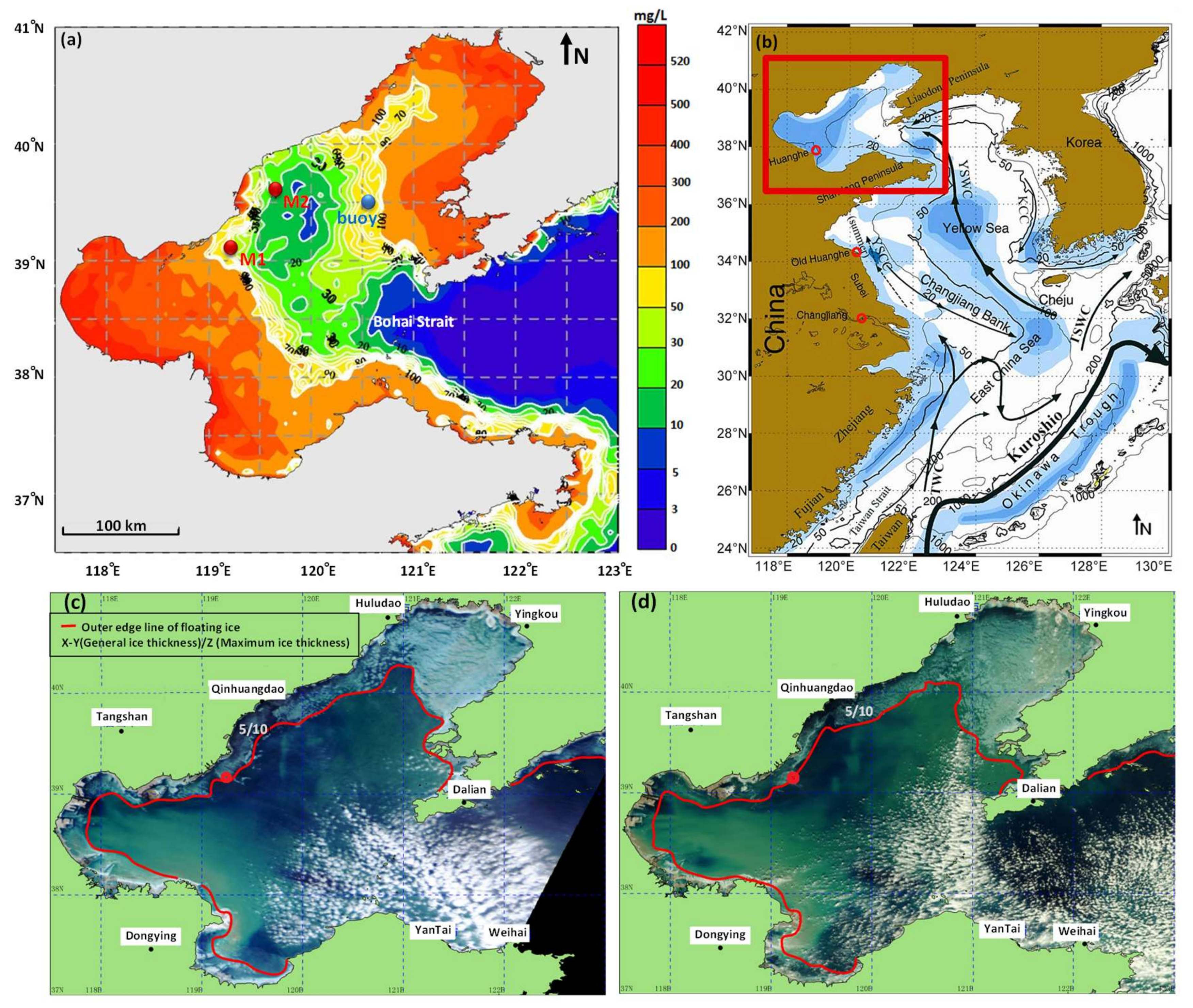
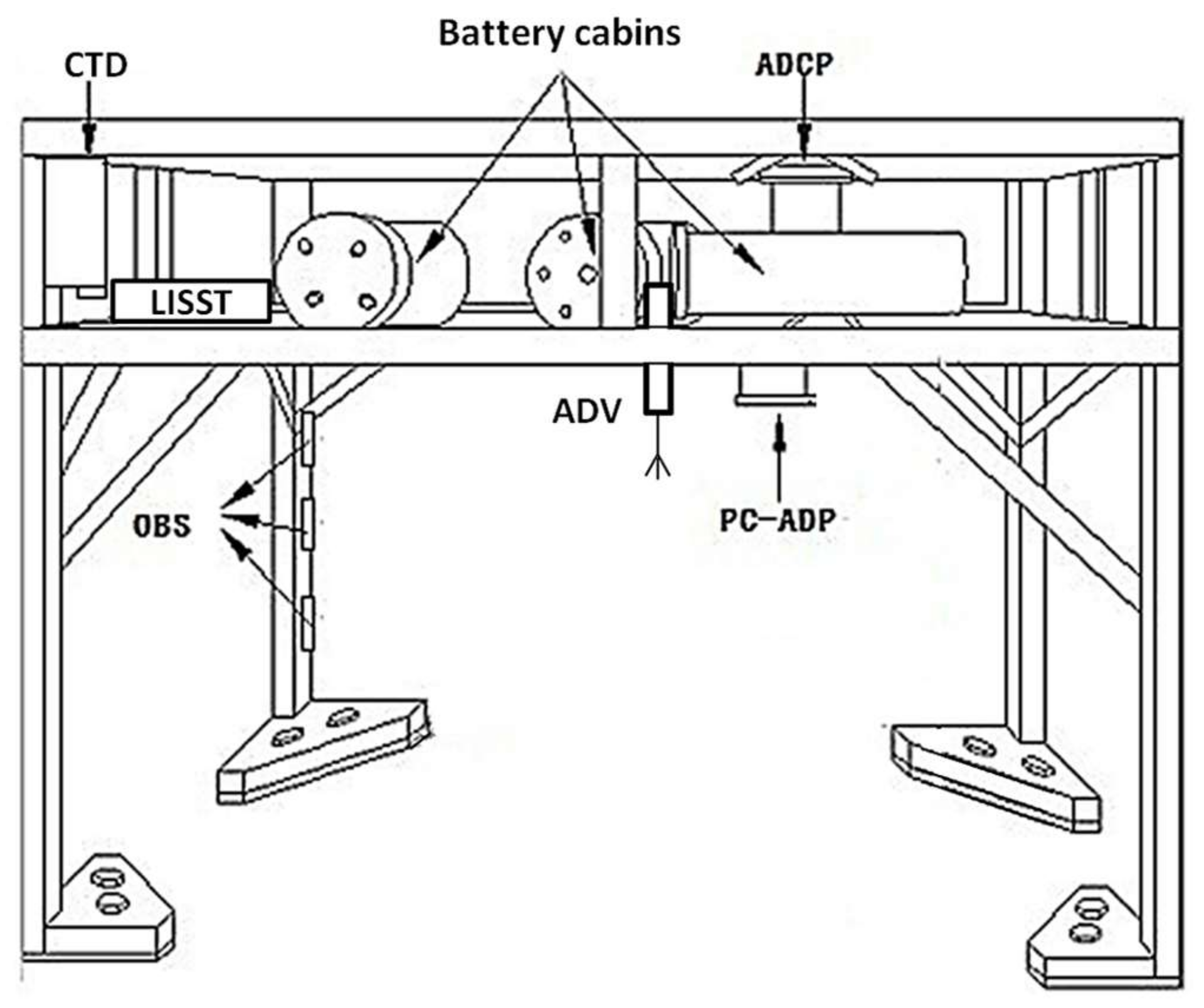
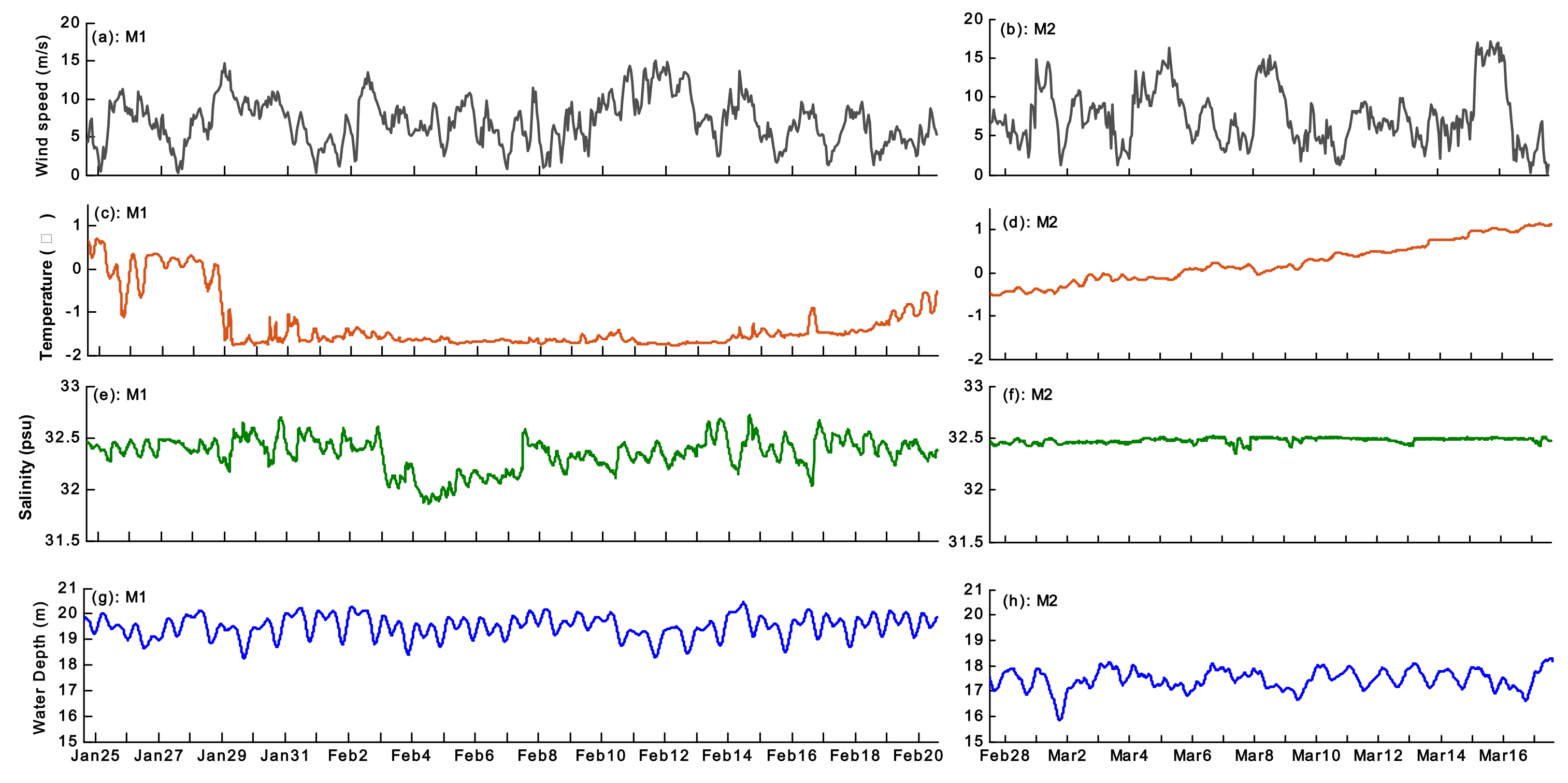
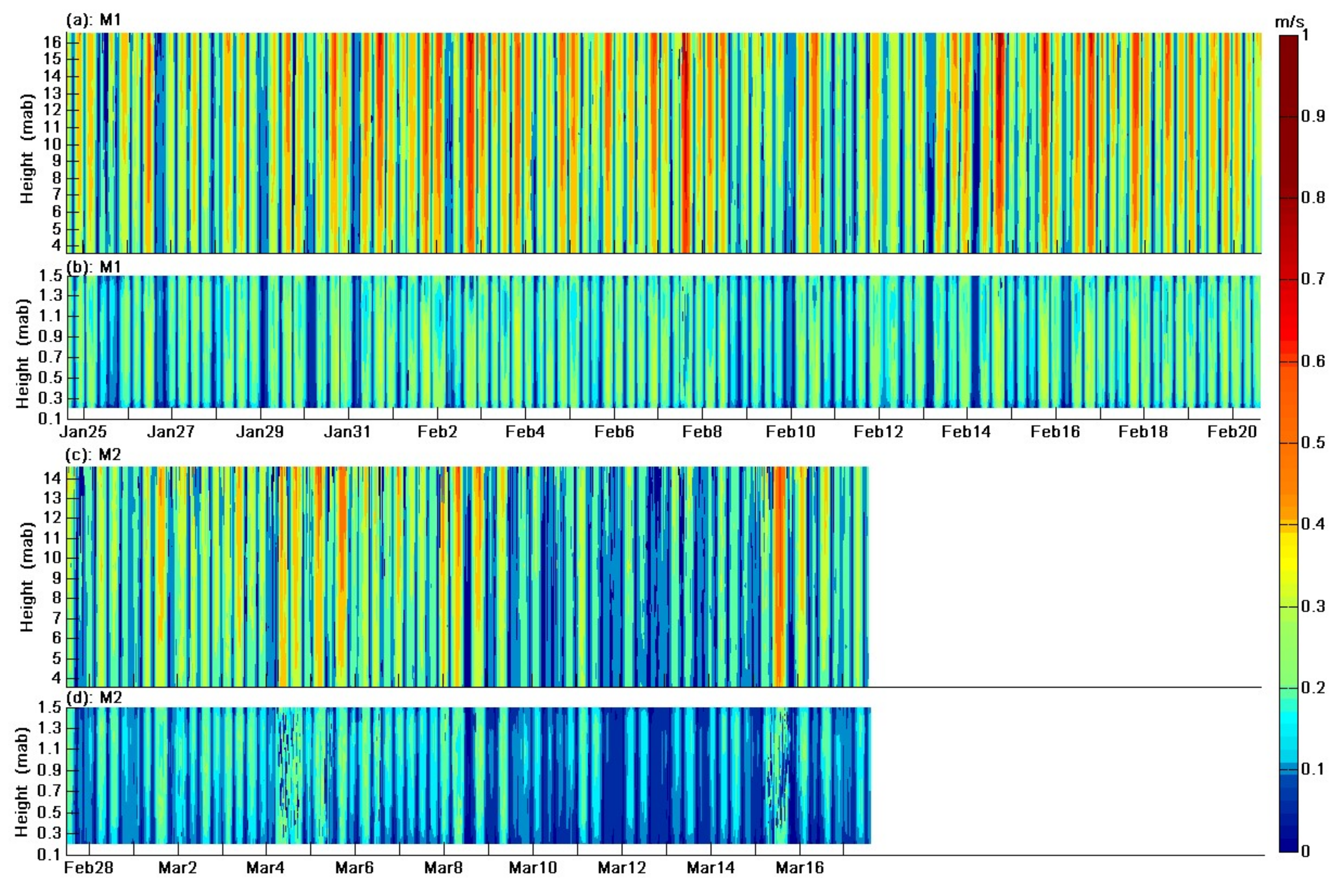
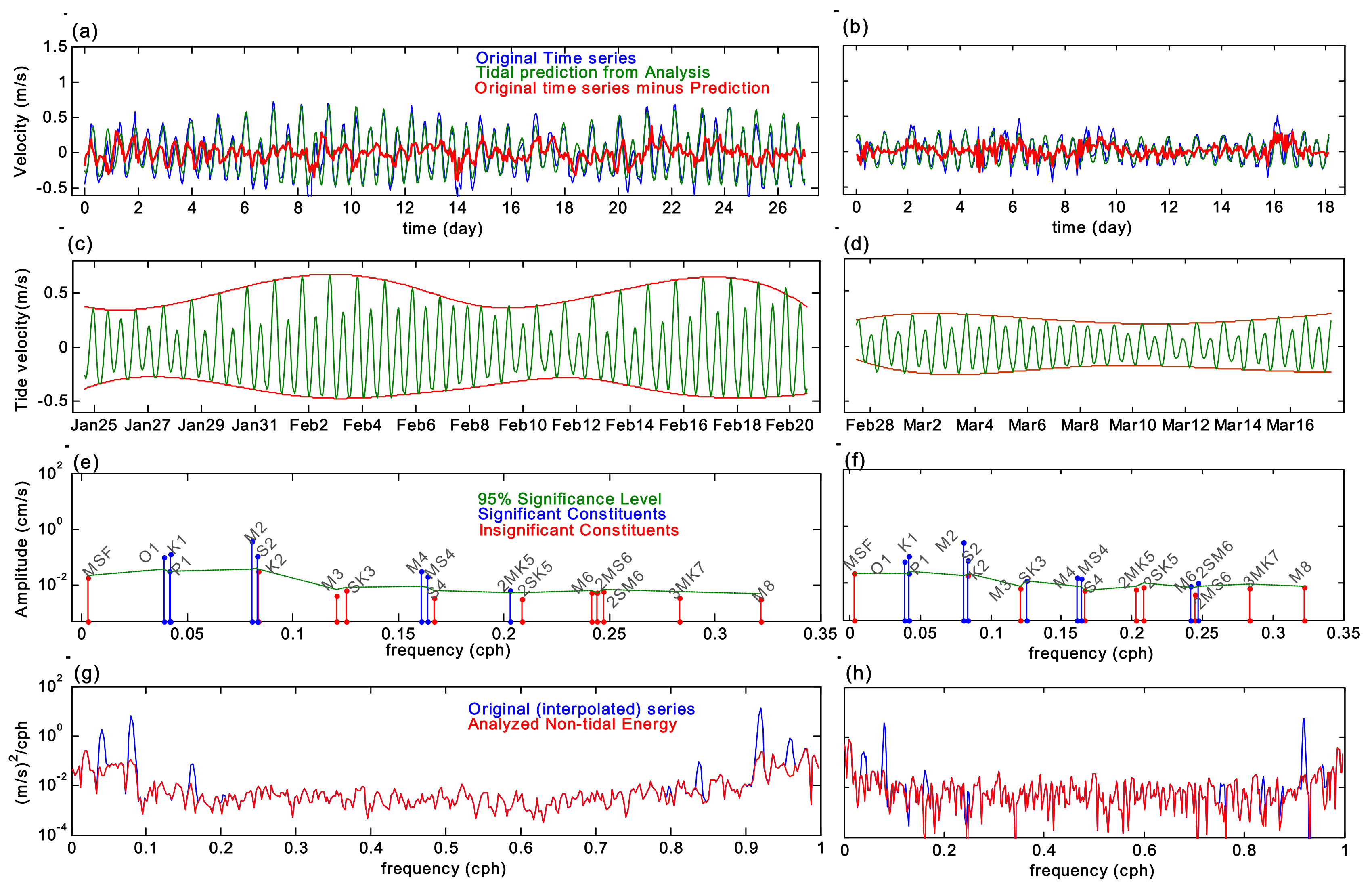
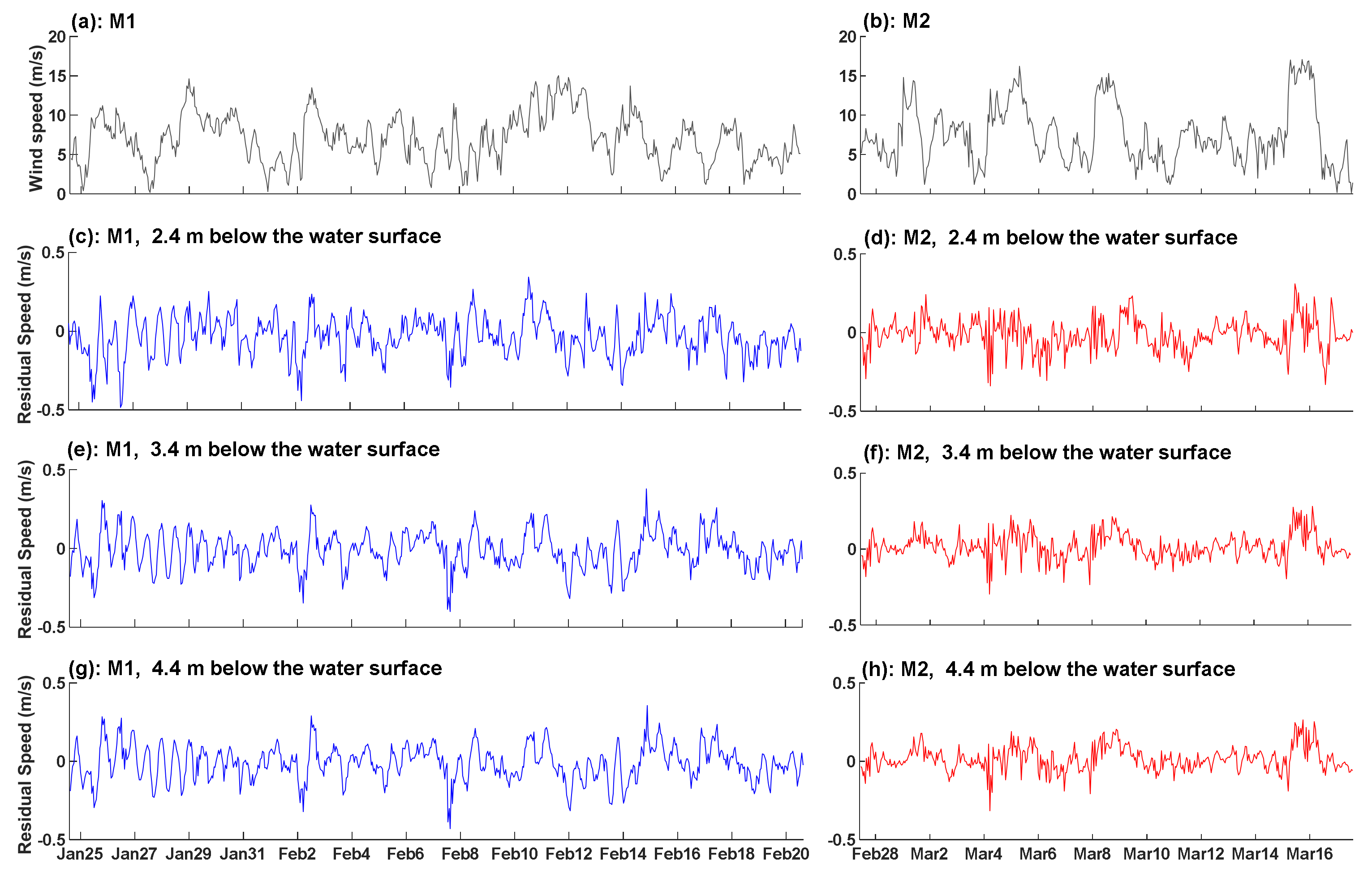
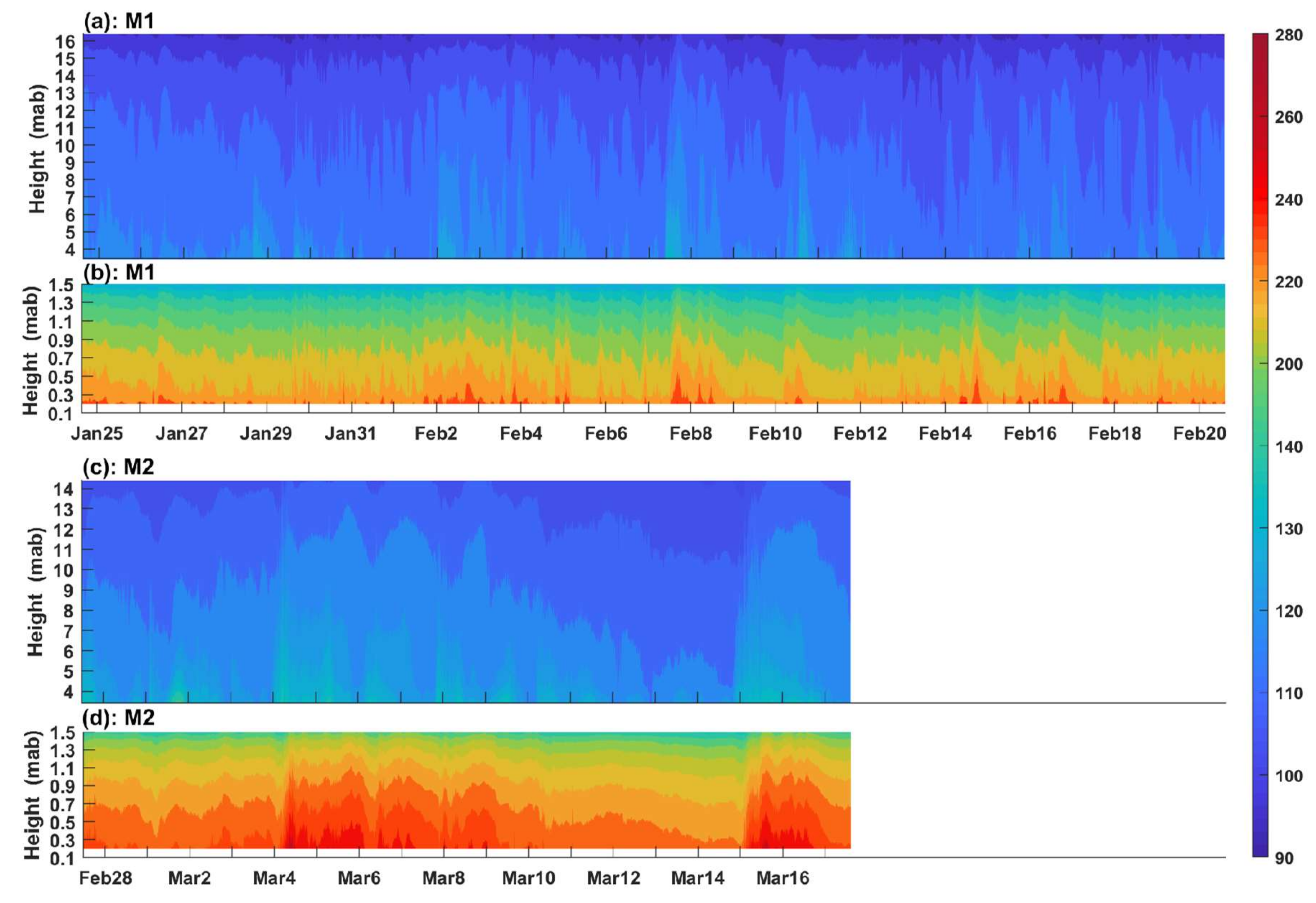
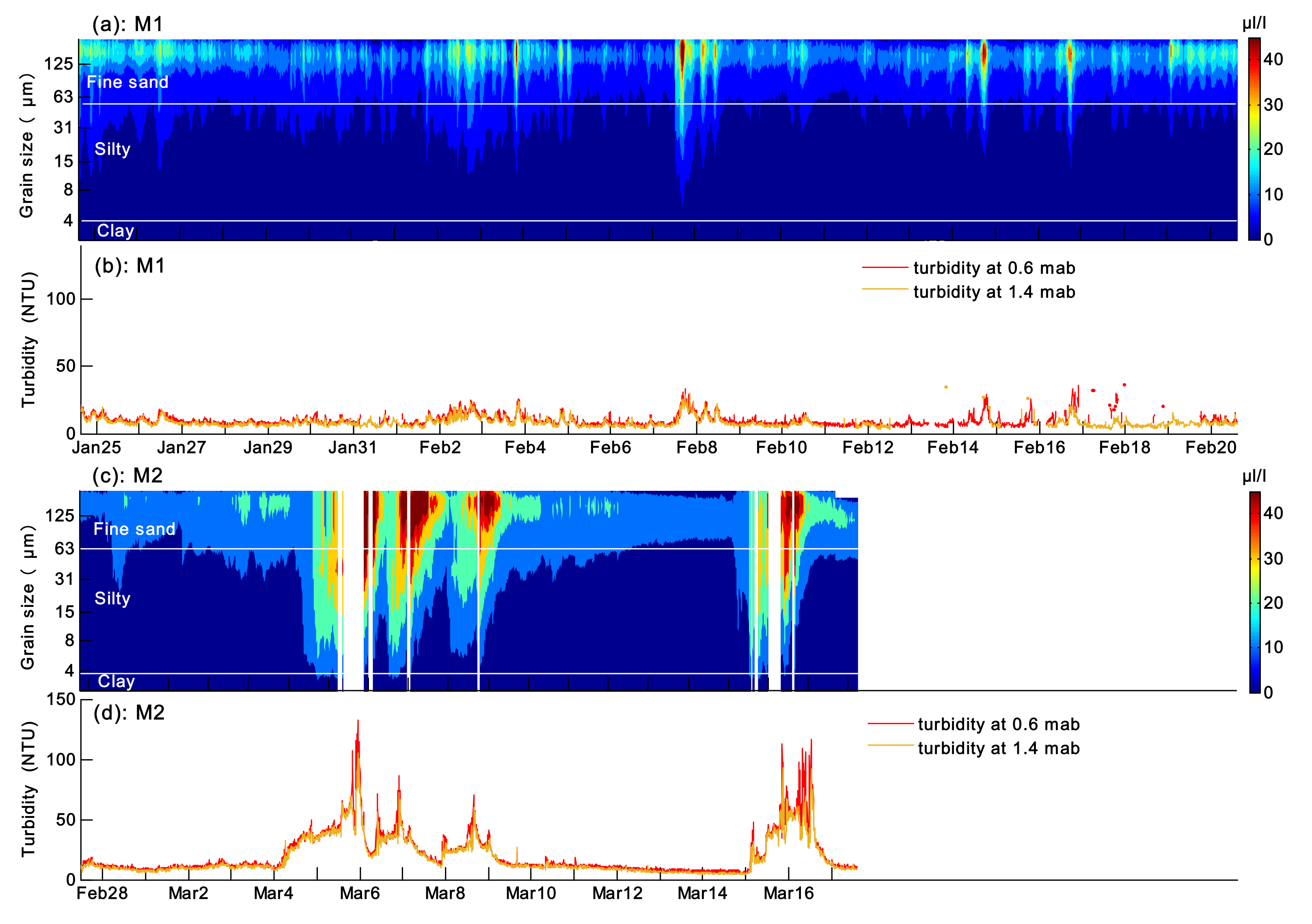
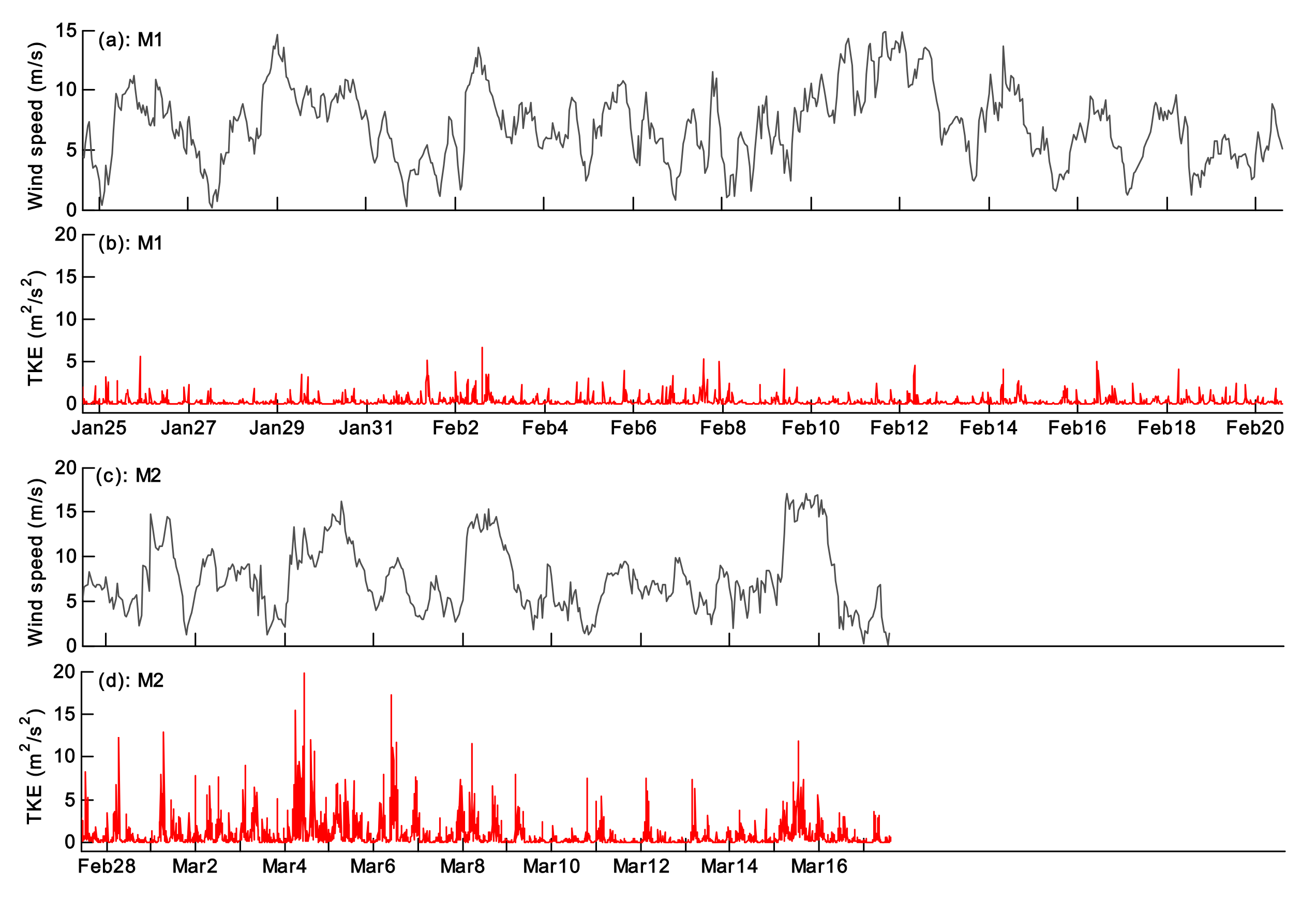
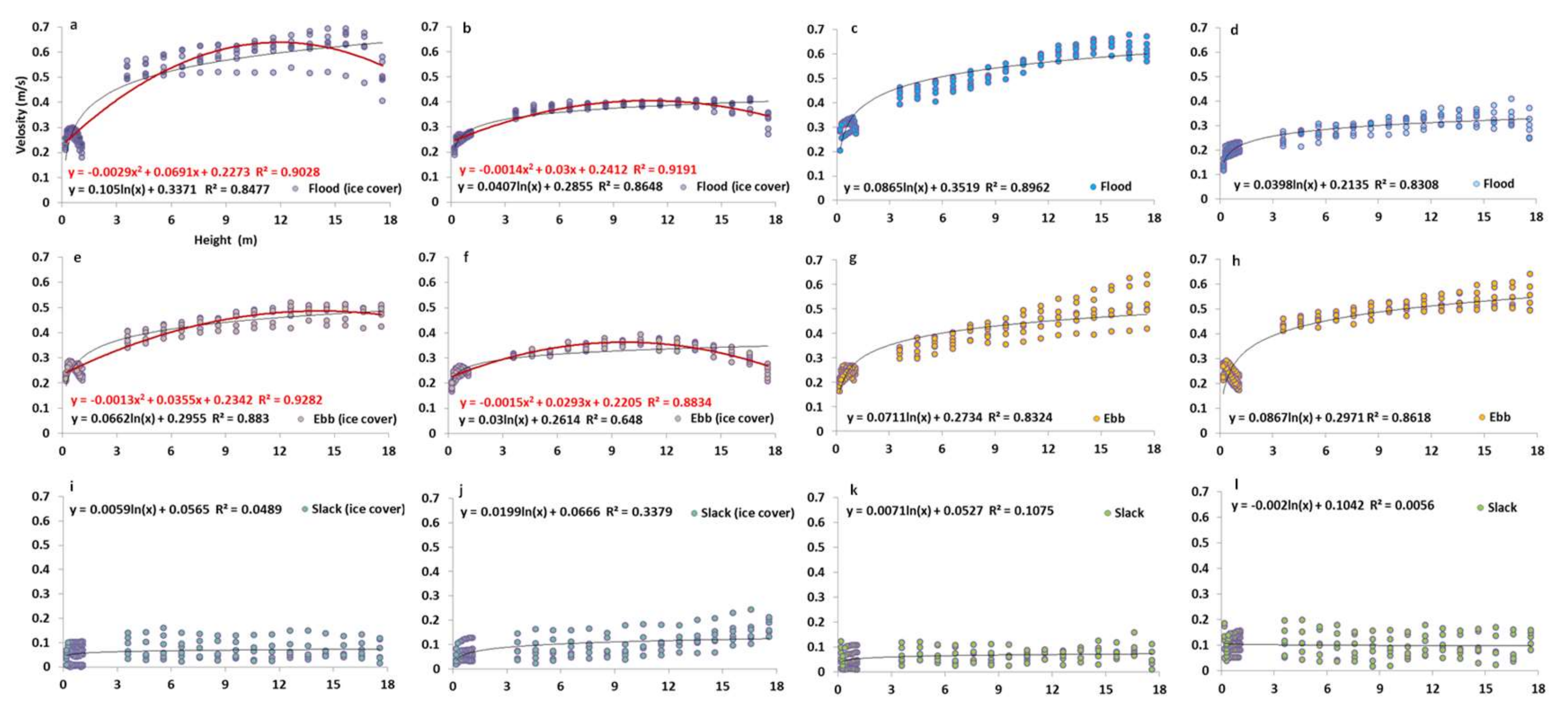
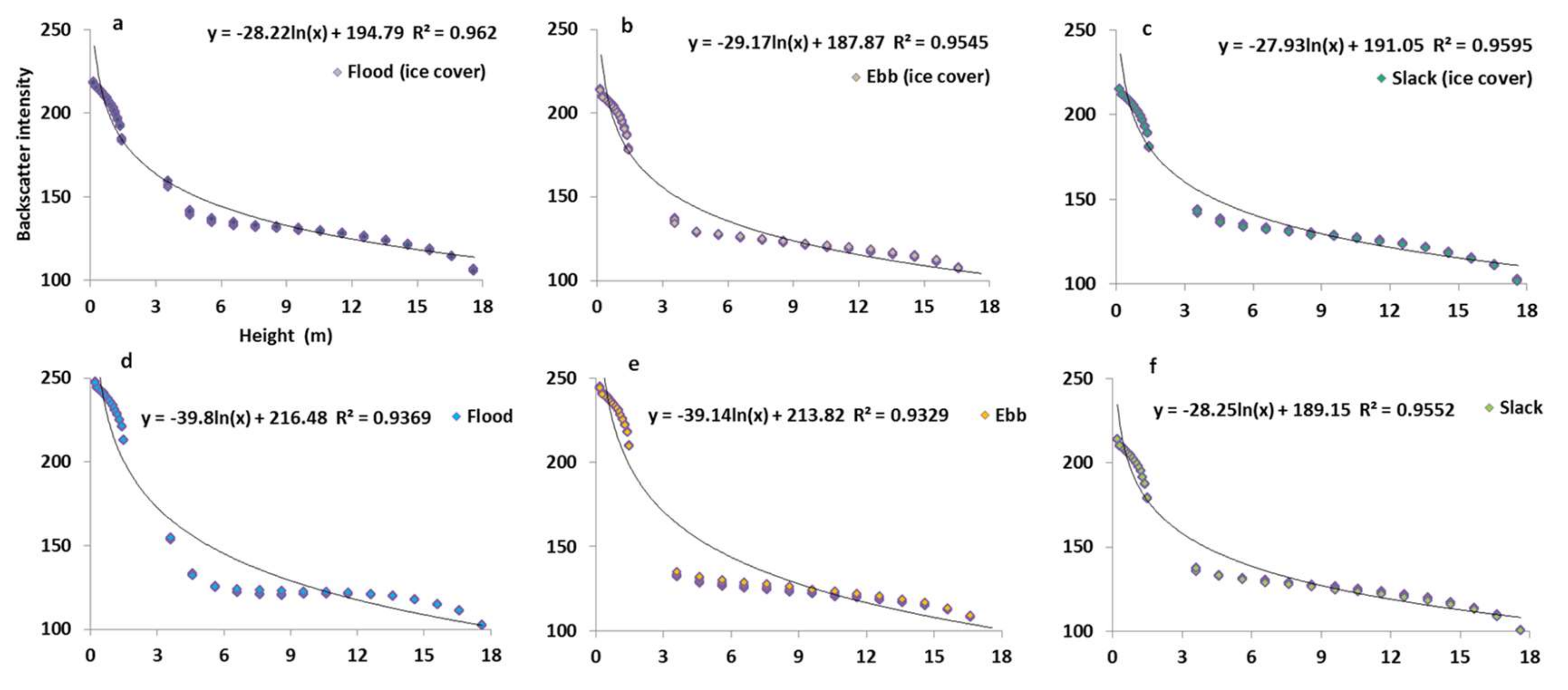
| Observation | Instrument | Height (mab 1) | Sampling Interval |
|---|---|---|---|
| Current velocity and echo | ADCP | 2 | 10 min |
| Current velocity and echo | PC-ADP | 1.55 | 10 min |
| High frequency velocity | ADV | 0.8 | 20 min (M1); 10 min (M2) |
| SSC (volume) and grain size | LISST | 1.8 | 30 min |
| Turbidity | OBS | 1.4/0.6 | 10 min |
| Temperature, salinity, and depth | CTD | 1.8 | 10 min |
© 2020 by the authors. Licensee MDPI, Basel, Switzerland. This article is an open access article distributed under the terms and conditions of the Creative Commons Attribution (CC BY) license (http://creativecommons.org/licenses/by/4.0/).
Share and Cite
Jiang, M.; Pang, C.; Liu, Z.; Jiang, J. Impact of Sea Ice on the Hydrodynamics and Suspended Sediment Concentration in the Coastal Waters of Qinhuangdao, China. Water 2020, 12, 611. https://doi.org/10.3390/w12020611
Jiang M, Pang C, Liu Z, Jiang J. Impact of Sea Ice on the Hydrodynamics and Suspended Sediment Concentration in the Coastal Waters of Qinhuangdao, China. Water. 2020; 12(2):611. https://doi.org/10.3390/w12020611
Chicago/Turabian StyleJiang, Man, Chongguang Pang, Zhiliang Liu, and Jingbo Jiang. 2020. "Impact of Sea Ice on the Hydrodynamics and Suspended Sediment Concentration in the Coastal Waters of Qinhuangdao, China" Water 12, no. 2: 611. https://doi.org/10.3390/w12020611
APA StyleJiang, M., Pang, C., Liu, Z., & Jiang, J. (2020). Impact of Sea Ice on the Hydrodynamics and Suspended Sediment Concentration in the Coastal Waters of Qinhuangdao, China. Water, 12(2), 611. https://doi.org/10.3390/w12020611





